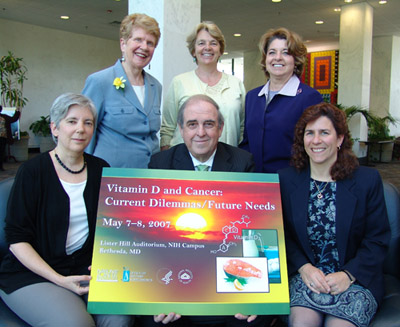Vitamin D and Cancer: Current Dilemmas/Future Needs
May 7-8, 2007, Bethesda, Maryland
More than 150 researchers from the United States and around the world attended the conference "Vitamin D and Cancer: Current Dilemmas/Future Needs" in May on the NIH Campus in Bethesda, MD. The conference addressed gaps in the literature on the role of vitamin D alone and in combination with genetic factors and other nutrients in preventing cancer.

Vitamin D and Cancer Planning Committee members (front row, from left), D. Michal Freedman, J.D., M.P.H., Ph.D., Epidemiologist, Division of Cancer Epidemiology and Genetics (DCEG); John Milner, Ph.D., Chief, Nutritional Science Research Group, Division of Cancer Prevention (DCP); Cindy Davis, Ph.D., Program Director, Nutritional Science Research Group, DCP.
In the back row, from left, Virginia Hartmuller, Ph.D., R.D., Acting Chief, Modifiable Risk Factors Branch, EGRP; Patricia Hartge, Sc.D.; Deputy Director, Epidemiology and Biostatistics Program, DCEG; and Mary-Frances Picciano, Ph.D., Senior Nutrition Research Scientist, NIH Office of Dietary Supplements (ODS).
Not pictured: Christine Swanson, Ph.D., Director, Dietary Supplements Research Centers Program, ODS.
Agenda
Participants focused on the following questions that could be made part of a research agenda for the future:
- How strong is the evidence that vitamin D status is related to cancer risk?
- How has nutrigenetics advanced our understanding of the relationship between vitamin D and cancer risk?
- What other genes determine the response to vitamin D?
- What are the important dietary components that modify the effect of vitamin D?
- What information have preclinical models provided about the relationship between vitamin D, calcium, and cancer?
Compelling evidence continues to accumulate on vitamin D's protective effects against cancer. Epidemiologic studies suggest that a deficiency of the vitamin is associated with increased risk for colorectal, prostate, and breast cancer, and perhaps for other cancers. The conference provided the opportunity to consider the state of the science on the vitamin and research that needs to be tackled next to more clearly understand its role in cancer risk.
Access the meeting agenda, abstracts, and the presentations .
.
Participants
Among the participants were EGRP-funded investigators who provided the epidemiologic perspective on the role of vitamin D and cancer risk, including Cedric Garland, Dr.P.H., University of California, San Diego; Edward Giovannucci, M.D., Sc.D., Harvard University; Sue Ingles, Dr.P.H., University of Southern California; Thomas Rohan, M.D., Ph.D., Albert Einstein School of Medicine; Martha Slattery, Ph.D., University of Utah; and Walter Willett, M.D., Dr.P.H., Harvard University.
Proceedings
A publication summarizing the proceedings was published in a supplement to the August 2007 issue of Nutrition Reviews:
Davis CD, Hartmuller V, Freedman M, Hartge P, Picciano MF, Swanson CA, Milner JA. Vitamin D and Cancer: Current Dilemmas and Future Needs . Nutr Rev. 2007; 65 (Supplement 1): 71-74.
. Nutr Rev. 2007; 65 (Supplement 1): 71-74.
Organizers and Sponsors
The workshop organizers were EGRP's Virginia (Ginny) Hartmuller, Ph.D., R.D., Acting Chief, Modifiable Risk Factors Branch; Patricia Hartge, Sc.D., DCCPS and DCEG; Cindy Davis, Ph.D., and John Milner, Ph.D., DCP; D. Michal Freedman, Ph.D., DCEG; and Mary-Frances Picciano, Ph.D., and Christine Swanson, Ph.D., ODS.
The workshop was cosponsored by NCI's Division of Cancer Control and Population Sciences (DCCPS), of which the EGRP is a part; the Division of Cancer Prevention (DCP); Division of Cancer Epidemiology and Genetics
(DCP); Division of Cancer Epidemiology and Genetics (DCEG); and the NIH Office of Dietary Supplements
(DCEG); and the NIH Office of Dietary Supplements (ODS).
(ODS).
Related Initiatives
A follow up conference was held on September 5-6, 2007 focusing on an evidence-based review of Vitamin D in food . Further details regarding the September 2007 conference can be obtained through the NIH Office of Dietary Supplements Web site
. Further details regarding the September 2007 conference can be obtained through the NIH Office of Dietary Supplements Web site .
.
The Vitamin D Pooling Project of Rarer Cancers (VDPP) brought together investigators from 10 cohorts to conduct a large prospective epidemiologic study of the association between vitamin D status (measured as serum concentrations of 25-hydroxyvitamin D) and endometrial, esophageal, stomach, ovarian, pancreatic, and kidney cancers, and non-Hodgkin lymphoma. Vitamin D levels in study participants were measured in serum collected before the development of cancer, an advantage in assessing whether vitamin D levels affected cancer susceptibility. Pooled analyses were conducted to assess potential associations between 25(OH)D and the seven rarer cancers. These analyses incorporated existing relevant case-control data from the participating cohorts. The findings from the VDPP do not support the hypothesis that circulating 25(OH)D concentrations are associated with a reduced risk of developing any of these seven rarer cancers. Learn more about the VDPP and its publications.


